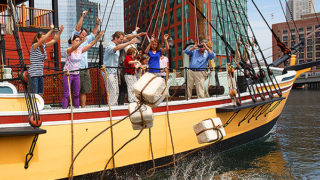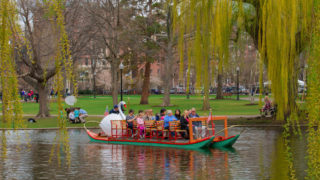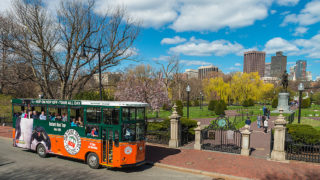Ultimate Guide to Boston Common

Established in 1634, the 50-acre Boston Common is the oldest public recreation area in the country. Colloquially known as “the Common,” the park is one of the gems in the Emerald Necklace, a series of parks, urban open spaces and greenways that meander through several Boston neighborhoods and stretch to Roxbury. Boston Common, situated across from the Massachusetts State House, forms the southern base of Beacon Hill and is delineated by Beacon, Park, Tremont, Boylston and Charles streets.
History of Boston Common
Grazing on the Common
Bostonians have used the park for a wide assortment of purposes throughout its storied history. Before the land became a treasured public space, it was part of a farm owned by Anglican priest William Blackstone, one of the city’s first European settlers. Early Puritan leaders of the Massachusetts Bay Colony purchased 44 acres of the land, which served as pasture for their livestock. A town shepherd, who tended the farm animals, was paid two schillings and sixpence per head. Although overgrazing ultimately limited its usefulness for this purpose, the Common was used to graze cattle until 1830.
Crime and Punishment
City leaders also built stocks and whipping posts to dispense punishment in the Common. The venue was the setting for several public executions. Before gallows were built in 1769, a large oak tree was used for hangings. It was from this tree that the Puritan leaders of Massachusetts executed Mary Dyer. The woman, along with three other people, was convicted of repeatedly disobeying the law that prohibited Quakers from practicing their religion in the colony. They have become known as the Boston martyrs and a bronze statue of Dyer stands on the grounds of the statehouse. Public executions on the Common were discontinued in 1817.
Let Your Voice Be Heard
In 1713, hundreds of citizens protesting food shortages and high bread prices rioted in the Common and shot the lieutenant governor. Bostonians also chose the area to celebrate the repeal of the Stamp Act in 1766 with bonfires and fireworks. During the occupation of the city after the Boston Tea Party, more than 1,000 British soldiers camped out in the Common. The selection of this public space as a “training field” was designed to prevent citizens from using it to stage their protests. It was from this militia encampment that three brigades of Redcoats departed for the trek to Lexington and Concord in April 1775. Also notable, the Common was the site of a rally commemorating the end of the Revolutionary War.
Public Gatherings
Continuing its legacy as a forum for oratory and public protest, Boston Common was the setting for a gathering honoring aviation pioneer Charles Lindbergh. During the 1960s, Martin Luther King, Jr. led a civil rights rally, and citizens protested the nation’s participation in the Vietnam War. In 1979, Pope John Paul II celebrated an open-air mass on the Common with approximately 400,000 worshipers.
Things to Do in Boston Common
Freedom Trail
Boston Common is the starting point and southern end of the Freedom Trail, a 2.5-mile-long pathway that winds through several neighborhoods. The trail connects 16 historical significant landmarks along a designated pathway. An organized tour is available or you may explore the trail at your own pace.
Noteworthy Plaques
There are also numerous attractions in the Common. Archaeological excavations have revealed prehistoric evidence of a Native American presence in the area that dates back almost 10,000 years. A historical inscription located at the intersection of Park Street and Tremont Street commemorates the original land purchase. A plaque identifies the location of the Great Elm Tree that stood in the center of the Common until it was destroyed by a storm in 1876.
Festive Outdoor Spaces
Built in 1912, the Parkman Bandstand is located on the eastern side of the park. It is named in honor of George Parkman who bequeathed $5 million for the care of the Common. The bandstand is used for alfresco concerts as well as political rallies and speeches. Boston Common is also the setting for the city’s Christmas tree lighting ceremony. A resplendent reflecting pool during warm weather, the Frog Pond serves as an outdoor skating rink during the winter months.
Monuments of Honor
There are several monuments in and around Boston Common. At the northeast corner of the park near the intersection of Beacon Street and Park Street is the Robert Gould Shaw Memorial, a bronze-relief sculpture by Augustus Saint-Gaudens. It depicts the 25-year-old colonel leading his African-American 54th Volunteer Infantry unit during their march down Beacon Street in May 1863. The regiment was immortalized in the highly acclaimed movie “Glory.” Situated atop Flag Staff Hill inside the park, the Soldiers and Sailors Monument is a victory column designed by Martin Milmore that honors the state’s Civil War dead. There is also a memorial honoring those killed during the Boston Massacre. The Oneida Football Monument identifies the Common as the site of the first organized football game played in the United States in 1862. The 22-foot-tall bronze Brewer Fountain is a replica of an original fountain featured at the 1855 Paris World Fair.
 Central Burying Ground
Central Burying Ground
Boston Common also contains the Central Burying Ground, which dates back to the mid-18th century. The site contains the graves of British soldiers and patriots who died at the Battle of Bunker Hill. Renowned painter Gilbert Stuart, composer William Billings and Boston Tea Party participant Samuel Sprague are also buried here. An area along the cemetery’s western edge known as the Dell contains a mass grave of remains unearthed during the construction of the subway in 1895.
 Getting to Boston Common
Getting to Boston Common
You can reach the Common by car or via the Park Street Red and Green Line station as well as the Green Line Boylston station on the subway. Opened in 1897, these two stops on the “T” are the oldest subway stations in the country. The Common is also a stop on the Old Town Trolley sightseeing tour. During the tour, your conductor will provide intriguing information and insider tidbits about the park and the surrounding area. Providing guests with enthralling “Transportainment®” for more than 40 years, Old Town Trolley is one of the best ways to see Boston and experience the fascinating history of the Cradle of Liberty.
Other Things to Do Nearby
Boston Common is adjacent to the Public Garden, where you’ll find the famous swan boats and artwork like the Make Way for Ducklings Statue. The nearby gold-domed Massachusetts State House features guided tours of the building and grounds that contain several well-known sculptures. The historic Park Street Church (summer time only) and Granary Burying Ground are also nearby. In addition to the original Cheers pub that inspired the long-running television show, the area around the park is home to the Boston Opera House as well as the Orpheum and Paramount theaters. The Common is within a brief walk of Chinatown and the trendy Newbury Street shopping district. Lodging near the Common includes the Four Seasons Boston, the Hyatt Regency Boston and the Omni Parker Hotel.
Best Time to Visit
Boston attracts throngs of visitors year-round; however, the best time to visit is between April and November before cold weather and snow descends on the city. Many people come to town for special springtime events, such as the Boston Marathon and graduation ceremonies held by the colleges and universities in the area. Families are more likely to visit in July and August when the city hosts thrilling outdoor events like the Fourth of July fireworks extravaganza and summer concert series. As the season progresses, there are fewer tourists and hotel rates begin dropping. If you’re looking for a good deal on accommodations, the holiday season will be your best time to do so. During the remainder of the year, you should book accommodations as early as possible to guarantee your spot.
Weather Considerations
Although spring and fall temperatures average in the high 60s and low 70s, there may be early- or late-season snowstorms. While summer brings humidity and highs in the 90s, winter can deliver heavy snow and temperatures that drop below freezing. It is best to monitor weather reports and dress in layers so that you can be comfortable regardless of the temperature. Be sure to pack a winter coat and footwear if you plan to visit the city from December through March.

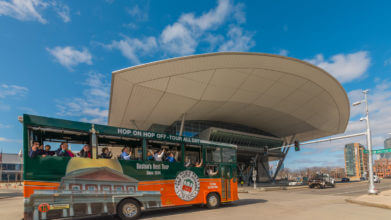

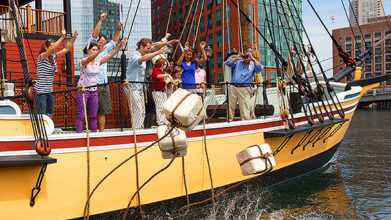

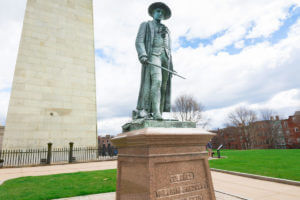 Central Burying Ground
Central Burying Ground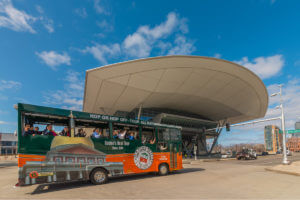 Getting to Boston Common
Getting to Boston Common